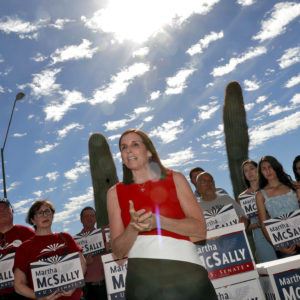America benefits when qualified, enthusiastic women and men seek to serve their country and run for elected office. For too long, women shied away from getting into campaigns as the candidate for a variety of reasons: Some women are reluctant to fund-raise or take on the grueling schedule and public scrutiny that can come with modern campaigns. Party leaders sometimes failed to encourage women to seek elected positions.
This is changing: Twice as many Republican women are seeking House seats this election as compared to 2016; Democrats also have record numbers of females running for office. This is great news: More choices for voters should lead to better representatives in office.
Yet Americans shouldn’t cast their vote for a woman, simply because she is a woman, anymore than they would cast their vote for a man, because he’s a man. In either case, it’s sex discrimination and a bad way to select a public representative.
The desire to have more women in leadership positions is understandable. It is exciting to see people from under-represented groups getting the recognition and opportunities they deserve. It shows that we are leaving the vestiges of discrimination and sexism behind as a country.
However, voters aren’t asked to choose between two candidates who represent their sex and race. Rather, we choose among individuals who are unique and complex, and who often have very different priorities and beliefs about the best policy choices to make to support all Americans and for the country at large.
We need to weigh all of these factors and the different positions that candidates take on issues as important as our national security, tax and budget plans, and the best path forward for our health care system. These matters can and should overwhelm any tribal sense of wanting to vote for someone simply because they share our sex.
Too many political commentators missed this obvious point and seemed to assume that women would — and had a duty to — support Hillary Clinton for president, simply because she was a fellow female. That was insulting to Clinton and to women voters. Clinton’s supporters surely didn’t believe that the fact that she was a woman was enough of a reason to put her in office. Presumably they thought that her background, experience and her vision for the country was superior to her opponent’s.
Female voters didn’t overwhelmingly vote for Clinton out of a duty to the sisterhood. In fact, in spite of all the hype about Clinton’s historic candidacy — and media coverage suggesting that Donald Trump was a particular threat to women — women voted in 2016 much like they did in 2012 and 2008. Trump received 41 percent of the votes cast by women, while Mitt Romney had receive 44 percent and John McCain 43 percent.
Those women who voted for Trump over Clinton weren’t rejecting the idea of having a female president, but had decided that they preferred what Trump promised to do as president, over what Clinton promised.
Surveys show that Americans of all political ideologies are willing to cast their votes for female candidates and are comfortable with the idea of female political leaders. This means that sooner or later, we will have a female president. When this happens, she will take office because voters believe she was the best person to lead the country, not because anyone decide it was just “time for a woman.”
That’s as it should be and isn’t sexism, but the absence of it.

